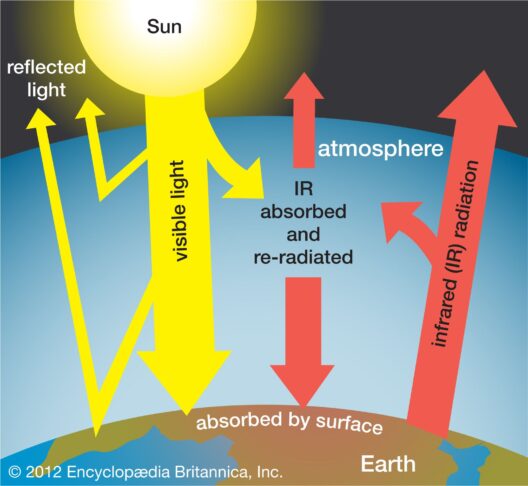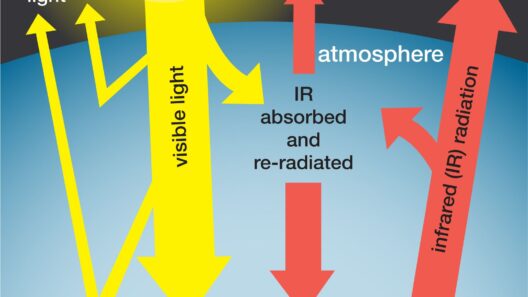Acid rain is often viewed as a local environmental concern, typically associated with industrial pollutants and their immediate effects on ecosystems. However, its intricate connection to global warming is frequently overlooked. Understanding this relationship not only provides insight into the multifaceted nature of climate change but also emphasizes the urgency of addressing air quality issues in the broader context of environmental protection.
The term “acid rain” refers to any form of precipitation—rain, snow, fog, or hail—that has a high acidity level, primarily due to the presence of sulfur dioxide (SO₂) and nitrogen oxides (NOₓ), which are released into the atmosphere through industrial processes, vehicle emissions, and other human activities. Once in the atmosphere, these pollutants undergo complex chemical reactions, resulting in the formation of sulfuric and nitric acids. When these acids fall to the ground, they can have devastating impacts on soil, water bodies, and vegetation.
On the other hand, global warming is primarily driven by the accumulation of greenhouse gases (GHGs) in the atmosphere, with carbon dioxide (CO₂) being the most significant. The burning of fossil fuels—a primary source of both CO₂ and the precursors to acid rain—offers a critical link between these two environmental phenomena. The paradox lies in recognizing how controlling one can inadvertently affect the other, creating an opportunity for synergistic solutions.
One of the most prominent ways acid rain interacts with global warming is through its impact on plant life. Trees, particularly in temperate forests, are vital carbon sinks, absorbing CO₂ and mitigating some effects of climate change. However, acid rain can significantly degrade forest vitality by leaching essential nutrients from the soil and impairing the health of trees. Nutrient deficiency can lead to stunted growth and increased susceptibility to pests and diseases. As trees die off or decline in health, their ability to sequester carbon diminishes, further exacerbating atmospheric CO₂ levels and, consequently, global warming.
The aquatic ecosystems also bear the brunt of this hidden link. Acid rain can cause severe harm to freshwater systems by lowering pH levels, disrupting the life cycles of aquatic organisms including fish, amphibians, and invertebrates. Healthy water bodies are crucial for carbon cycling; they not only capture carbon but also produce oxygen and support biodiversity. As ecosystems collapse due to acidification, the carbon they once stored is released back into the atmosphere, creating a feedback loop that accelerates climate change.
Furthermore, acid rain’s effect on soil chemistry merits attention. The alterations in soil pH not only hinder crop yields but also affect the soil’s microbial community. Healthy soil is crucial for carbon storage and thus plays a fundamental role in regulating atmospheric CO₂. Many farmers may not realize the invisible consequences of acid rain on their land, which, in the long term, could translate into economic and agricultural distress as soil health deteriorates.
Additionally, while acid rain predominantly arises from sulfur and nitrogen compounds, the contribution of GHGs to its formation is a critical topic of study. Acidic precipitation is more likely to occur under certain climatic conditions, which are influenced by global warming. For example, increased temperatures can heighten the frequency of weather events conducive to acid rain formation. This creates a perilous cycle where climate change exacerbates the factors leading to acid rain, which in turn contributes to the ongoing dilemma of global warming.
Addressing the hidden link between acid rain and global warming requires multifaceted strategies. Transitioning towards cleaner energy sources is crucial. The reduction of fossil fuel consumption can yield a dual benefit: lowering both greenhouse gas emissions and the precursors to acid rain. Renewables such as wind, solar, and hydroelectric power offer sustainable alternatives that can mitigate these interrelated issues.
Policy plays an instrumental role as well. Stringent regulations on emissions can serve as a critical tool in managing both acid rain and climate change. Policies designed to limit sulfur dioxide and nitrogen oxides emissions can lead to significant improvements in air quality while simultaneously curbing the progression of global warming. In the United States, the Clean Air Act has been instrumental in reducing acid rain, showcasing successful policy measures that could be reinforced or replicated globally.
As individuals, community actions can amplify efforts to combat both climate change and acidification. Transitioning to energy-efficient systems, advocating for stringent environmental protections, and educating others about the connection between air quality and climate change can foster a culture of accountability.
The connection between acid rain and global warming shines a light on the comprehensive nature of environmental issues. Recognizing that these two seemingly distinct phenomena are intricately linked is not only crucial for understanding their impacts but also vital for formulating effective solutions. By acknowledging this relationship, a paradigm shift emerges where tackling air pollution can play a pivotal role in the battle against climate change, driving home the importance of holistic environmental stewardship. As we seek solutions, the dialogue surrounding climate action must integrate every facet of our ecosystem, revealing that the integration of policies and education can catalyze progress toward a more sustainable future.








